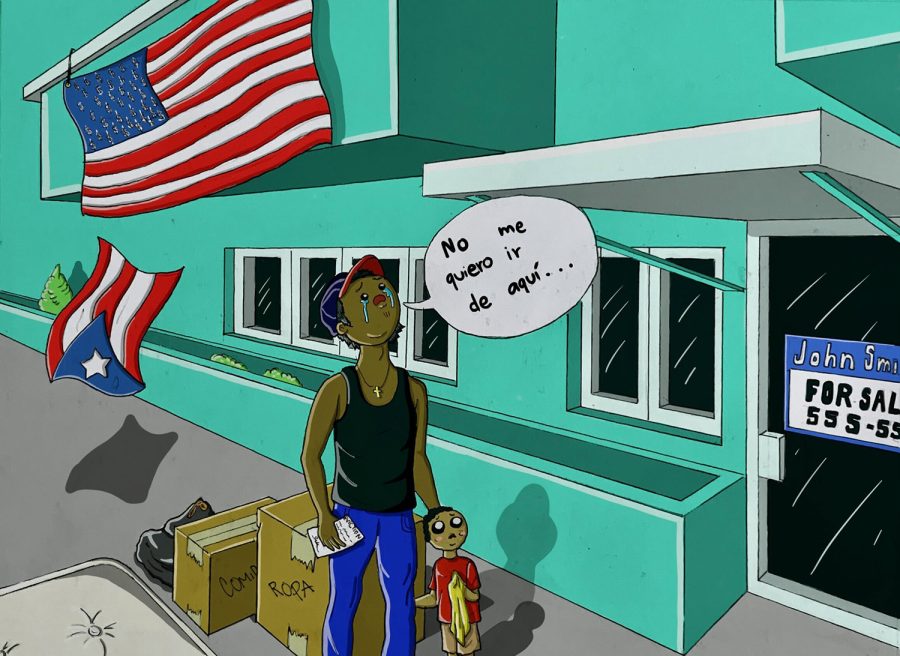Bad Bunny video highlights issues facing Puerto Ricans
Illustration
October 7, 2022
“Este es mi playa, este es mi sol, este es mi tierra, este soy yo.”
These are the words that are sung throughout Bad Bunny’s newest music video for El Apagón, an anthem for Puerto Rico off of his latest album “Un Verano Sin Ti.”
The global artist, whose name is Benito Martínez Ocasio, highlighted ongoing issues in Puerto Rico, such as blackouts and gentrification, in the nearly 23-minute video released on Sept. 16.
Bad Bunny does not shy away from speaking on Puerto Rican issues that matter to him, so it is no surprise that he followed his music video with a short documentary titled “Aquí Vive Gente,” by independent Puerto Rican reporter Bianca Graulau.
In under 24 hours, the video turned documentary received nearly three million views and high praise from viewers across social media.
The video’s comment section held many comments from Puerto Ricans themselves thanking the artist for highlighting issues that they face daily, and urging others to watch the video.
Graulau’s documentary opens up with Maricusa Hernández, a Puerto Rican resident from the Dominican Republic. She is being forced to move out of her home that she has been renting for 26 years because the building has a new owner.
“They’re displacing Puerto Ricans to get rich from what is here … with what is native from here,” Hernández said.
In the past few years, the U.S territory has seen an influx of wealthy Americans purchasing property.
Graulau tells viewers that the country is seeing a wave of investors because of Act 22.
Act 22, also called the Individual Investors Act, is a tax incentive code that allows new wealthy investors that officially reside in Puerto Rico to avoid paying income tax.
According to the documentary, more than 3,000 people benefited from this act. Eight beneficiaries have bought 28 properties in one neighborhood, including one that used to be a public school.
“We’ll be foreigners in our own land,” said Jorge Luis Gonzales in the documentary. Gonzales is a resident of Puerta de Tierra who was displaced when his home was purchased to be turned into more expensive condos.
However, this act is not the only way for investors to get significant tax breaks via buying buildings and displacing residents.
CSUN sociology professor Daniel Olmos said that tax breaks happen both on the local and federal level. “In 2017, [President Donald] Trump passed a tax law where essentially 95% of Puerto Rico was created as an opportunity zone, so capitalists came in to get their benefits. And then the local government of Puerto Rico did their own tax breaks, so it was basically a double whammy.”
Olmos referred to the Tax Cuts and Jobs Act that was heavily criticized by some as only benefiting the wealthy. This legislation made it easier for investors to buy property in places like Puerto Rico, which Olmos said will increase gentrification.
“Gentrification is a global phenomenon, but what is happening in Puerto Rico is really acute and really, really stark, and I am glad that Bad Bunny, with his notoriety, is able to spotlight this issue by literally giving the mic over to communities who are struggling on the ground,” said Olmos.
The documentary also highlights the impact of recent hurricanes on the island, such as Hurricane Maria.
According to a report by the National Hurricane Center, Hurricane Maria was a Category 4 storm that was the most destructive hurricane the island has ever seen.
According to the report, the storm knocked down around 80% of the utility poles and transmission lines, leading to 3.4 million residents on the island losing power.
The island was left with a struggling power grid that left some without power. To this day, the island still faces the aftermath of the hurricane by having multiple blackouts a day.
After the damages of Maria, the Puerto Rican government hired LUMA Energy, a joint U.S. and Canadian private energy company, to fix the power grid. Still, the video criticizes them for not restoring and updating the power.
Olmos believes the video gained much popularity online because so many people were unaware of the issues that the country has been facing for so long.
“The cultural and economic history of Puerto Rico, as it relates to the U.S. body politic, has been one of erasure, of evasion, and part of the struggle for us here in the U.S. is to be aware. It is a matter of education and raising our consciousness to understand that we are all connected to a larger power struggle,” said Olmos.
Aside from the social issues, the video also highlighted the culture and beauty of the island and of the people that live there.
The beginning of the video featured shots of the island, including its colorful neighborhoods and the beauty of the ocean that sits on the front yard of those who own homes on the beachfront.
The video wraps up with residents reminding viewers that their fight is not over.
“Resistance will last here until the very end,” said an interviewee.
So for those who are not Puerto Rican, perhaps the video is not just a way to shine a light on these issues. Perhaps, it is a call for help to an island that has faced many challenges but still continues to keep its hope that one day, it will see a change to the place many call home.
In the words of Bad Bunny himself, “Puerto Rico está bien cabrón.”
